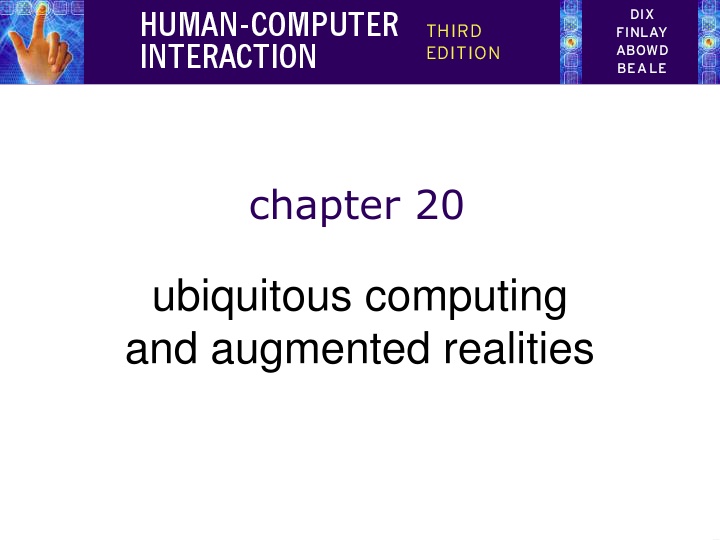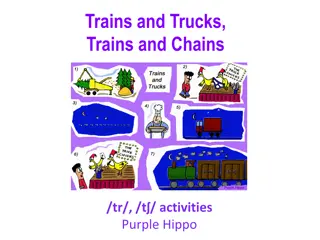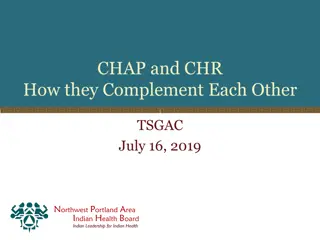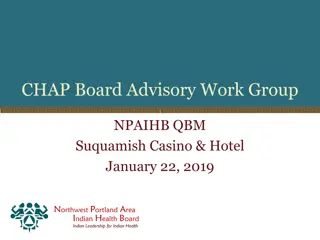
Exploring Ubiquitous Computing and Augmented Realities
"Discover the world of ubiquitous computing and augmented realities, where technology seamlessly integrates into our everyday lives. From challenging HCI assumptions to defining interactive experiences, explore the implications and applications of these cutting-edge technologies."
Download Presentation

Please find below an Image/Link to download the presentation.
The content on the website is provided AS IS for your information and personal use only. It may not be sold, licensed, or shared on other websites without obtaining consent from the author. If you encounter any issues during the download, it is possible that the publisher has removed the file from their server.
You are allowed to download the files provided on this website for personal or commercial use, subject to the condition that they are used lawfully. All files are the property of their respective owners.
The content on the website is provided AS IS for your information and personal use only. It may not be sold, licensed, or shared on other websites without obtaining consent from the author.
E N D
Presentation Transcript
chapter 20 ubiquitous computing and augmented realities
ubiquitous computing and augmented realities ubiquitous computing filling the real world with computers virtual and augmented reality making the real world in a computer!
Challenging HCI Assumptions What do we imagine when we think of a computer? The most profound technologies are those that disappear. Weiser 1990 s: this was not our imagined computer!
Ubiquitous Computing Any computing technology that permits human interaction away from a single workstation Implications for Technology defining the interactive experience Applications or uses Underlying theories of interaction
Scales of devices Weiser proposed Inch Foot Yard Implications for device size as well as relationship to people
Device scales Inch PDAs PARCTAB Voice Recorders smart phones Individuals own many of them and they can all communicate with each other and environment.
Device scales Foot notebooks tablets digital paper Individual owns several but not assumed to be always with them.
Device scales Yard electronic whiteboards plasma displays smart bulletin boards Buildings or institutions own them and lots of people share them.
Defining the Interaction Experience Implicit input Sensor-based input Extends traditional explicit input (e.g., keyboard and mouse) Towards awareness Use of recognition technologies Introduces ambiguity because recognizers are not perfect
Different Inputs Sensors on a PDA Capacitive sensing on a table
Multi-scale and distributed output Screens of many sizes (very) small (very) large Distributed in space, but coordinated
The output experience More than eye-grabbing raster displays Ambient: use features of the physical environment to signal information Peripheral: designed to be in the background Examples: The Dangling String The Water Lamp (shown)
Merging Physical and Digital Worlds How can we remove the barrier? Actions on physical objects have meaning electronically, and vice versa Output from electronic world superimposed on physical world A digital desk An augmented calendar
Application Themes Context-aware computing Sensed phenomena facilitate easier interaction Automated capture and access Live experiences stored for future access Toward continuous interaction Everyday activities have no clear begin-end conditions
New Opportunities for Theory Knowledge in the world Ubicomp places more emphasis on the physical world Activity theory Goals and actions fluidly adjust to physical state of world Situated action and distributed cognition Emphasizes improvisational/opportunistic behavior versus planned actions Ethnography Deep descriptive understanding of activities in context
Evaluation Challenges How can we adapt other HCI techiques to apply to ubicomp settings? Ubicomp activities not so task-centric Technologies are so new, it is often hard to get long-term authentic summative evaluation Metric of success could be very different (playfulness, non-distraction versus efficiency)
ambient wood real wood! filled with electronics light and moisture meters recorded with GPRS location drawn on map later periscope shows invisible things uses RFID triggered sound
City - shared experience visitors to Mackintosh Interpretation Centre some on web, some use VR, some really there interacting talk via microphones see each other virtually different places different modalities shared experience
virtual and augmented reality VR - technology & experience web, desktop and simulators AR mixing virtual and real
virtual reality technology headsets allow user to see the virtual world gesture recognition achieved with DataGlove (lycra glove with optical sensors that measure hand and finger positions) eyegaze allows users to indicate direction with eyes alone whole body position sensed, walking etc.
VR headsets small TV screen for each eye slightly different angles 3D effect
immersion VR computer simulation of the real world mainly visual, but sound, haptic, gesture too experience life-like situations too dangerous, too expensive see unseen things: too small, too large, hidden, invisible e.g. manipulating molecules the experience aim is immersion, engagement, interaction
on the desktop headset VR expensive, uncomfortbale desktop VR use ordinary monitor and PC cheap and convenient in games and on the web VRML virtual reality markup language
VRML VR on the web #VRML V1.0 ascii Separator { Separator { # for sphere Material { emmissiveColor 0 0 1 # blue } Sphere { radius 1 } } Transform { translation 4 2 0 } Separator { # for cone Texture2 { filename "big_alan.jpg" } Cone { radius 1 # N.B. width=2*radius height 3 } } }
command and control scenes projected on walls realistic environment hydraulic rams! real controls other people for: flight simulators ships military
augmented reality (AR) images projected over the real world aircraft head-up display semi-transparent goggles projecting onto a desktop types of information unrelated e.g. reading email with wearable related e.g. virtual objects interacting with world issues registration aligning virtual and real eye gaze direction
applications of AR maintenance overlay instructions display schematics examples photocopier engineers registration critical arrows point to parts aircraft wiring looms registration perhaps too hard, use schematic
applications of VR simulation games, military, training VR holidays rainforest, safari, surf, ski and moon walk all from your own armchair medical surgery scans and x-rays used to build model then practice operation force feedback best phobia treatment virtual lifts, spiders, etc.
information and data visualisation VR, 3D and 2D displays scientific and complex data interactivity central
scientific and technical data number of virtual dimensions that are real three dimensional space visualise invisible fields or values e.g. virtual wind tunnel two dimensional space can project data value up from plane e.g. geographic data N.B. viewing angle hard for static visualisation no real dimensions 2D/3D histograms, scatter plots, pie charts, etc.
virtual wind tunnel fluid dynamics to simulate air flow virtual bubbles used to show movements better than real wind tunnel no disruption of air flow cheaper and faster
structured informnation scientific data just numbers information systems lots of kinds of data hierarchies file trees, organisation charts networks program flow charts, hypertext structure free text documents, web pages
visualising hiererchy 2D organisation chart familiar representation what happens when it gets wide? managing director sales manager marketing manager production manager F. Bloggs F. Bloggs A. Jones R.Carter K. West B. Firth J. Smith P. Larkin
wide hierarchies use 3D? managing director sales manager marketing manager production manager F. Bloggs F. Bloggs A. Jones R.Carter K. West B. Firth J. Smith P. Larkin cone trees (Xerox) levels become rings overlap OK in 3D
networks in 2D network or graph : nodes e.g. web pages links may be directed or not e.g. links planar can drawn without crossing non-planar any 2D layout has crossings Planar graph Non-planar graph
time and interactivity visualising in time time dimension mapped to space changing values: sales graphs, distance-time events: Gantt chart, timelines, historical charts e.g. Lifelines visualising medical and court records using time data dimension mapped to time time to itself: fast/slow replay of events space to time: Visible Human Project interactivity change under user control e.g. influence explorer
between two worlds ubiquitous computing computers fill the real world virtual reality and visualisation real world represented in the computer augmented reality, ambient displays physical and digital intermingled maturity VR and visualisation commonplace AR, ubiquity coming fast!






